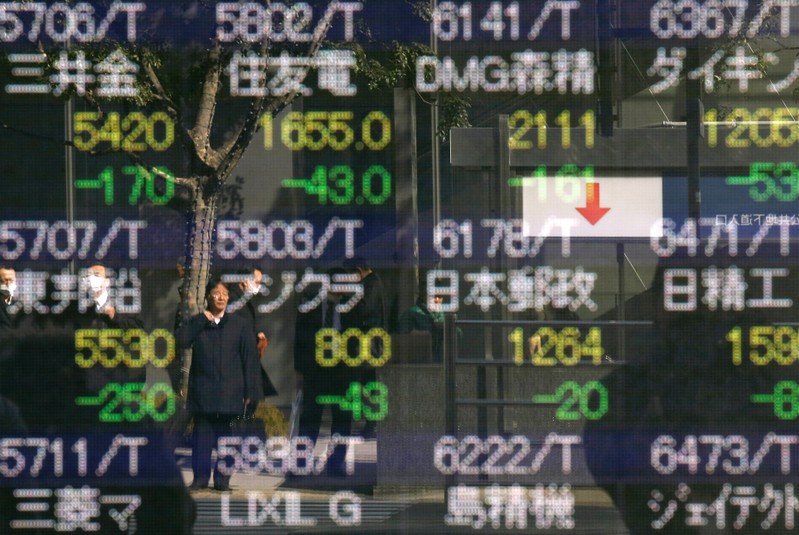
A man is reflected in an electronic stock quotation board outside a brokerage in Tokyo, Japan February 9, 2018. REUTERS/Toru Hanai
August 27, 2018
By Andrew Galbraith
SHANGHAI (Reuters) – Asian shares rose on Monday, boosted by record Wall Street highs on Friday after reassuring comments from the Federal Reserve’s chairman, and as stock markets in China gained after the country’s central bank tweaked its management of the yuan.
MSCI’s broadest index of Asia-Pacific shares outside Japan <.MIAPJ0000PUS> was up 1.1 percent, while Japan’s Nikkei stock index <.N225> gained 0.9 percent.
Helping to brighten the mood, U.S. and Mexican trade negotiators are seen as close to reaching a common position on the North American Free Trade Agreement (NAFTA), with Mexican Economy Minister Ildefonso Guajardo saying on Sunday talks have “continued to make progress”.
A prospective trade deal with Mexico “takes a little bit of global trade war risk off the table,” said Robert Carnell, chief economist and head of research, Asia-Pacific at ING.
“Every time there’s a move toward fewer tariffs from the U.S. instead of more, then that should take a little pressure off the U.S. dollar,” he said.
“The rest of the world doesn’t particularly want a much stronger dollar, because it makes their currencies weak and it means that their central banks have to respond with tighter policy, everything else being equal, which weighs on domestic demand.”
Seoul’s Kospi index <.KS11> advanced 0.3 percent.
In China, the Shanghai Composite index <.SSEC> added 1.4 percent and the blue-chip CSI300 index <.CSI300> rose 1.9 percent, after the People’s Bank of China late on Friday revived a “counter-cyclical factor” used to set the midpoint of the daily trading band of the yuan, in a bid to support it.
The move raised hopes that a yuan recovery could boost companies with significant dollar-denominated costs, such as airlines. China Southern Airlines <600029.SS> gained 4.2 percent and Air China <601111.SS> rose 3.7 percent.
The yuan hit a two-and-a-half-week high against the U.S. dollar in early trade on Monday as the PBOC set the day’s midpoint <CNY=PBOC> at a stronger-than-expected level.
At 0341 GMT, the yuan <CNY=CFXS> was trading at 6.8110 per dollar, 80 pips stronger than Friday’s onshore close of 6.8190.
“China just seems to be stabilizing its currency and we’re getting used to that fact now, so we’re not looking at an ever-weaker CNY, which could raise issues,” said Carnell, adding that “it reduces the scope for outflows.”
On Friday, the S&P500 index <.SPX> and Nasdaq Composite <.IXIC> hit record highs, following comments from the chairman of the U.S. Federal Reserve, Jerome Powell, who said a gradual approach to raising rates was best to protect the U.S. economy and job growth.
The gains cemented the S&P’s longest-running bull market, as defined by some investors.
S&P500 E-mini futures <ESc1> touched a record high of 2,885 on Monday morning in Asia, and were last 0.26 percent higher at 2,884.25.
“Powell’s Jackson Hole speech essentially confirmed the need for further gradual rate hikes and stressed that higher interest rates have served the economy well. However, rate rises remain data-dependent, and other Fed officials reiterated that ‘nothing is predetermined’,” ANZ analysts said in a note on Monday.
“The Fed Chair’s reiteration that rate rises would remain gradual gave the green light to ongoing falls in the USD and increases in equities on Friday.”
U.S. President Donald Trump said in a Reuters interview last week that he was “not thrilled” with Powell’s rate hike policy, seeking more help with the economy from the Fed instead.
The yield on benchmark 10-year Treasury notes <US10YT=RR> was at 2.8188 percent, compared with its U.S. close of 2.826 percent on Friday. The two-year yield <US2YT=RR>, which rises with traders’ expectations of higher Fed fund rates, touched 2.6286 percent compared with a U.S. close of 2.629 percent.
Australian shares wavered between gains and small losses, following a week of political tumult that saw Scott Morrison become the country’s sixth prime minister in less than 10 years.
The S&P/ASX 200 index <.AXJO> was 0.3 percent higher.
The dollar fell 0.15 percent against the yen to 111.05 <JPY=>, while the euro <EUR=> was up 0.1 percent on the day at $1.1630.
The dollar index <.DXY>, which tracks the greenback against a basket of six major rivals, was down 0.07 percent at 95.075.
U.S. crude <CLc1> was 0.06 percent lower at $68.68 per barrel, and Brent crude <LCOc1> fell to $75.76 per barrel after oil prices rose last week, ending a streak of weekly declines on tightening supply, driven by the prospect of lower oil supply from Iran.
The United States has pulled out of a nuclear accord it signed with Iran in 2015 and has imposed sanctions on Iran’s oil industry and exports.
Gold edged higher as the dollar weakened. Spot gold <XAU=> gained 0.14 percent to trade at $1,207.24 per ounce.
(Reporting by Andrew Galbraith; Editing by Eric Meijer and Richard Borsuk)

